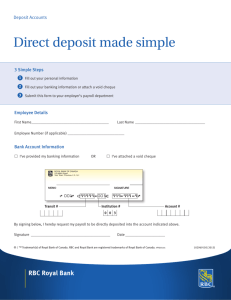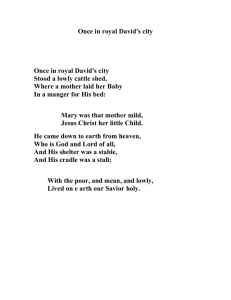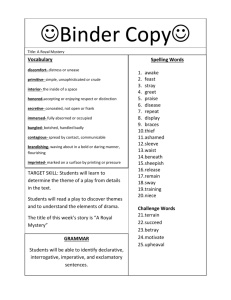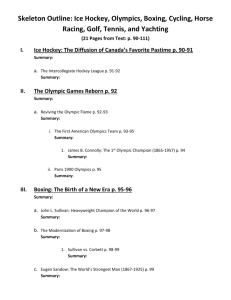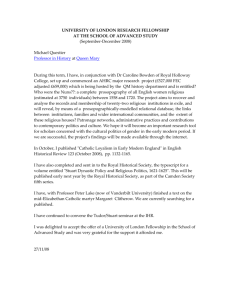RYA Powerboat Slideshow
advertisement
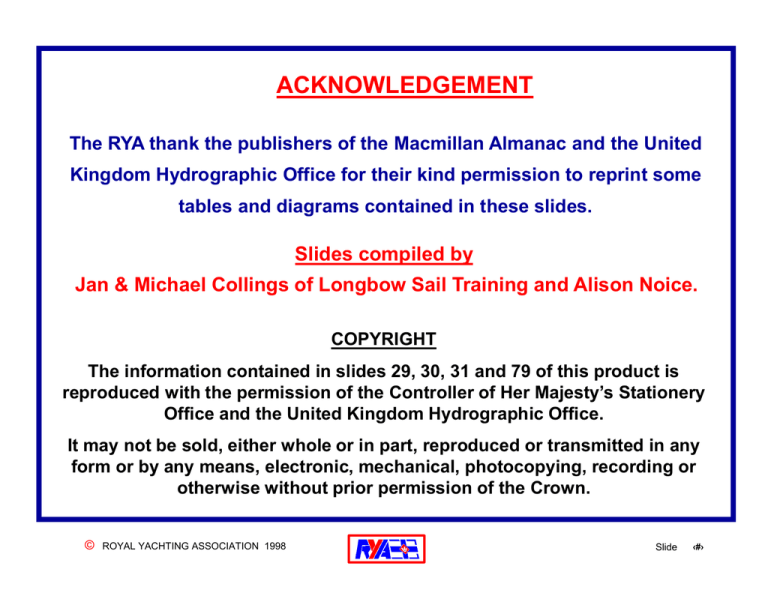
ACKNOWLEDGEMENT The RYA thank the publishers of the Macmillan Almanac and the United Kingdom Hydrographic Office for their kind permission to reprint some tables and diagrams contained in these slides. Slides compiled by Jan & Michael Collings of Longbow Sail Training and Alison Noice. COPYRIGHT The information contained in slides 29, 30, 31 and 79 of this product is reproduced with the permission of the Controller of Her Majesty’s Stationery Office and the United Kingdom Hydrographic Office. It may not be sold, either whole or in part, reproduced or transmitted in any form or by any means, electronic, mechanical, photocopying, recording or otherwise without prior permission of the Crown. © ROYAL YACHTING ASSOCIATION 1998 Slide ‹#› RYA NATIONAL CRUISING SCHEME TEACHING SLIDES FOR THEORY COURSES © ROYAL YACHTING ASSOCIATION 1998 Slide ‹#› RYA NATIONAL CRUISING SCHEME • Competent Crew • Day Skipper • Coastal Skipper © ROYAL YACHTING ASSOCIATION 1998 Slide ‹#› RYA NATIONAL CRUISING SCHEME • • • • • Competent Crew Day Skipper Theory Day Skipper Coastal Skipper/Yachtmaster Offshore Theory Coastal Skipper • Yachtmaster Ocean Theory © ROYAL YACHTING ASSOCIATION 1998 Slide ‹#› RYA NATIONAL CRUISING SCHEME • • • • • • • • • Competent Crew Day Skipper Theory Day Skipper Coastal Skipper/Yachtmaster Offshore Theory Coastal Skipper Coastal Skipper Exam Yachtmaster Offshore Exam Yachtmaster Ocean Theory Yachtmaster Ocean Exam © ROYAL YACHTING ASSOCIATION 1998 Slide ‹#› SAILS AND RIGGING Backstay Boom Forestay Inner Forestay Genoa Working Jib Mainsail Storm Jib Head Cap Shroud Luff Spreader Leech Lower Shroud Tack Foot © ROYAL YACHTING ASSOCIATION 1998 Clew Slide ‹#› SAILS AND RIGGING Wind Indicator Topping Lift ° ° Reefing Cringle ° ° ° ° Reefing Pennant ° ° Clew Outhaul Furling Drum Mainsheet Furling Line © Batten ROYAL YACHTING ASSOCIATION 1998 Boom Kicking Strap Slide ‹#› POINTS OF SAIL STARBOARD TACK WIND In Stays (In Irons) PORT TACK Close Hauled (Beating) 45º Beam Reach No Go Zone 45º Fine or Close Reach 90º 90º Running by The Lee Broad Reach Dead Run © ROYAL YACHTING ASSOCIATION 1998 Slide ‹#› TYPES OF ROPE Kevlar Polyester Polypropylene Nylon © ROYAL YACHTING ASSOCIATION 1998 Slide ‹#› SECURING TO A CLEAT © ROYAL YACHTING ASSOCIATION 1998 Slide ‹#› SECURING A COIL TO A CLEAT © ROYAL YACHTING ASSOCIATION 1998 Slide ‹#› COILING A ROPE © ROYAL YACHTING ASSOCIATION 1998 Slide ‹#› KNOTS, BENDS & HITCHES Sheet Bend Double Sheet Bend Bowline © ROYAL YACHTING ASSOCIATION 1998 Figure of Eight Slide ‹#› KNOTS, BENDS & HITCHES Clove Hitch Reef Knot Rolling Hitch Round Turn and 2 Half Hitches © ROYAL YACHTING ASSOCIATION 1998 Slide ‹#› MOTOR CRUISER © ROYAL YACHTING ASSOCIATION 1998 Slide ‹#› CRUISING YACHT © ROYAL YACHTING ASSOCIATION 1998 Slide ‹#› ANCHOR TERMINOLOGY Eye for tripping line Fid (to secure stock) Shank Stock Fluke Crown Shank © ROYAL YACHTING ASSOCIATION 1998 Slide ‹#› Fisherman & Can stow flat & Good on rock & Few moving parts & Poor power/weight ratio & Upstanding fluke can foul chain & Stock pin needs wire mousing Grapnel & Easily folded & Best in weed & Useful in small & Poor power/weight ratio & Clumsy to handle & Can pinch fingers craft © ROYAL YACHTING ASSOCIATION 1998 Slide ‹#› CQR & Good power/weight ratio & Plough digs into most types of ground & Forged steel very strong & Difficult to stow & Can capsize (but usually resets) Danforth & Can stow flat & Good holding in soft ground © & & & & Shingle can jam or trip Not good on rock Hard to break out of mud Can catch fingers ROYAL YACHTING ASSOCIATION 1998 Slide ‹#› Bruce & Excellent power/weight ratio & No moving parts to jam & Easy to break out & Difficult to stow except on bow roller & Not good on weedy or hard ground & Smaller sizes may not dig in easily Delta & & & & Sets fast and digs deep Excellent power/weight ratio Does not capsize Can self-launch/free-fall from bow roller & Difficult to stow except on bow roller © ROYAL YACHTING ASSOCIATION 1998 Slide ‹#› ANCHORING Anchors in tandem Running Moor Strongest stream Heaviest anchor Scope Chain - 4 x depth Warp - 6 x depth © ROYAL YACHTING ASSOCIATION 1998 40° Slide ‹#› ANCHORING ! Be clear of Fairways Dangers Other anchored craft ! Depth Now LW HW ! Shelter Now Later © ROYAL YACHTING ASSOCIATION 1998 ! Tidal Stream Direction Speed Turn ! Wind Direction Speed ! Can you get away? In a crisis At night ! Type of Holding Slide ‹#› MOORING ALONGSIDE Bow Ropes Back Spring Bow Shoreline Fore Spring Stern Rope Stern Shoreline Fore spring stops the boat going forwards Back spring stops the boat going backwards © ROYAL YACHTING ASSOCIATION 1998 Slide ‹#› LATITUDE & LONGITUDE Northern Hemisphere Meridian x Latitude Latitude Equator Longitude Southern Hemisphere Longitude (from Greenwich) © ROYAL YACHTING ASSOCIATION 1998 Slide ‹#› CHART PROJECTIONS Mercator Transverse Mercator Latitude N E W S Longitude Used for Large Scale charts where meridians appear parallel © ROYAL YACHTING ASSOCIATION 1998 Slide ‹#› CHART PROJECTIONS Gnomonic Gnomonic Latitude Longitude © ROYAL YACHTING ASSOCIATION 1998 Slide ‹#› RHUMB LINE SAILING Gnomonic Projection Great Circle Rhumb Line Great Circle Rhumb Line Mercator Projection © ROYAL YACHTING ASSOCIATION 1998 Slide ‹#› CHART DESCRIPTION ENGLAND - SOUTH COAST MANACLE POINT TO BOLT HEAD DEPTHS IN METRES SCALE 1:150,000 at Lat 50 00´ Depths are in metres and are reduced to Chart Datum, which is approximately the level of Lowest Astronomical Tide. Heights are in metres. Underlined figures are drying heights above Chart Datum; all other heights are above Mean High Water Springs. Positions are referred to European Datum (1950). Navigational marks: IALA Maritime Buoyage System - Region A (Red to port). Projection: Mercator. Sources: The origin, scale, date and limits of the hydrographic information used to compile the chart are shown in the Source Data diagram. © ROYAL YACHTING ASSOCIATION 1998 Slide ‹#› COMPASS ROSE © ROYAL YACHTING ASSOCIATION 1998 Slide ‹#› TIDAL DIAMONDS & DATUMS C © ROYAL YACHTING ASSOCIATION 1998 50°16’.90 N 4 34.80 W Slide ‹#› TIDAL STREAM ATLAS Thickness and length of arrow indicate rate of tidal stream 15,31 © ROYAL YACHTING ASSOCIATION 1998 Slide ‹#› Mean Range DOVER COMPUTATION OF RATES TIDAL STREAM RATE (in tenths of a knot) 10 7m 20 30 40 50 60 70 6m Springs Springs 5m 4m Neaps Neaps 3m 2m Tenths of a Knot © 10 20 ROYAL YACHTING ASSOCIATION 1998 30 40 50 60 70 Slide ‹#› HOURS RELATED TO HIGH WATER HW - 2½ hrs 0930 HW - 1½ hrs 1030 HW - ½ hr 1130 HW + ½ hr 1230 HW + 1½ hrs 1330 HW + 2½ hrs 1430 HW - 2 HW - 1 1200 HW HW + 1 HW + 2 © ROYAL YACHTING ASSOCIATION 1998 Slide ‹#› DEAD RECKONING (DR) DR Deduced from Log and Compass Fix 0800 25.1M © Distance Run 6.2M ROYAL YACHTING ASSOCIATION 1998 DR 0900 31.3M Slide ‹#› DEAD RECKONING (DR) DR Deduced from Log and Compass Fix 0800 25.1M Distance Run 6.2M DR 0900 31.3M Tidal Stream . Estimated Position (No leeway) 0900 31.3M © ROYAL YACHTING ASSOCIATION 1998 Slide ‹#› DEAD RECKONING (DR) DR Deduced from Log and Compass Fix 0800 25.1M Distance Run 6.2M DR 0900 31.3M Tidal Stream . Ground Track 090° (T) Distance Made Good 7.2M © ROYAL YACHTING ASSOCIATION 1998 Estimated Position (No leeway) 0900 31.3M Slide ‹#› LEEWAY Wind Water Track 075°(T) Course Plotted Leeway 5° Water Track = Heading + or - LEEWAY © ROYAL YACHTING ASSOCIATION 1998 Slide ‹#› ESTIMATED POSITION WITH LEEWAY Wind Tidal Stream 5° 090°(T) © ROYAL YACHTING ASSOCIATION 1998 Slide ‹#› COURSE TO STEER (CTS) Tidal Stream 150°(T) EP 0800 25.1M . © ROYAL YACHTING ASSOCIATION 1998 Wind Ground Track Slide ‹#› COURSE TO STEER (CTS) Tidal Stream 150°(T) EP 0800 25.1M . Wind Ground Track Tidal Stream © ROYAL YACHTING ASSOCIATION 1998 Slide ‹#› COURSE TO STEER (CTS) Tidal Stream 150°(T) EP 0800 25.1M . Wind Ground Track Tidal Stream © ROYAL YACHTING ASSOCIATION 1998 Slide ‹#› COURSE TO STEER (CTS) Tidal Stream 150°(T) EP 0800 25.1M . Wind Ground Track Tidal Stream © ROYAL YACHTING ASSOCIATION 1998 Slide ‹#› ESTIMATED TIME OF ARRIVAL (ETA) Tidal Stream 150° (T) 0800 25.1M Ground Track . Distance to Destination 4.4M Distance Capability in 1 Hour 5.1M Duration of Passage = 4.4 x 60min = 52min 5.1 © ROYAL YACHTING ASSOCIATION 1998 ETA = 0800 + 0052 = 0852 Slide ‹#› PLOTTING SYMBOLS 1600 DR (Dead reckoning) 1945 EP (Estimated position) Fix (Observed position) OR 2006 Position line OR 2117 2253 Transferred position line Range / Distance off Depth contour line Water track Ground track Tidal stream © ROYAL YACHTING ASSOCIATION 1998 20 Slide ‹#› VARIATION Magnetic North True North T Easterly Variations M T M T Westerly Variations Magnetic South © ROYAL YACHTING ASSOCIATION 1998 Slide ‹#› MAGNETIC BEARINGS BEARING Magnetic Magnetic Bearing 071° North Variation 8°W True Bearing 063° © ROYAL YACHTING ASSOCIATION 1998 True North Slide ‹#› MAGNETIC BEARINGS BEARING Magnetic Magnetic Bearing 071° North Variation 8°W True Bearing 063° True North RELATIVE BEARING Boat's heading 305° (T) 55° W of N True Bearing 063° (T) Relative Bearing 118° to Starboard © ROYAL YACHTING ASSOCIATION 1998 Slide ‹#› DEVIATION ! Similar in application to variation ! Varies with boat's heading ! Need a current Deviation Chart for each fixed compass on board ! Not used with handbearing compass (but need to check for gross errors) ! Need to swing compass annually and check deviation occasionally © ROYAL YACHTING ASSOCIATION 1998 Slide ‹#› EFFECT OF COMPASS DEVIATION N W E S N N W E W E S S N W E S © ROYAL YACHTING ASSOCIATION 1998 Slide ‹#› COMPASS DEVIATION TABLE 6 West 4 2 0 East 2 4 000 045 090 135 180 225 270 315 360 © ROYAL YACHTING ASSOCIATION 1998 6 Ship's Head Compass (C) Deviation 000 022.5 045 067.5 090 112.5 135 157.5 180 202.5 225 247.5 270 292.5 315 337.5 360 4W 2W 0 2E 4E 5E 6E 5E 4E 2E 0 2W 4W 5W 6W 5W 4W Ship's Head Magnetic (M) 356 020.5 045 069.5 094 117.5 141 162.5 184 204.5 225 245.5 266 287.5 309 332.5 356 Slide ‹#› APPLYING CORRECTIONS True Direction apply Variation Magnetic Direction apply Deviation Compass Direction © ROYAL YACHTING ASSOCIATION 1998 Slide ‹#› MNEMONICS “Error West - Compass Best Error East - Compass Least” “Cadbury's Dairy Milk Very Tasty + Exciting (- W)” NB Order and sign of corrections are important © ROYAL YACHTING ASSOCIATION 1998 Slide ‹#› DEVIATION CONVERSIONS Finding Course to Plot Compass Course Steered 240°(C) Deviation (from table) 2° W Magnetic Course 238°(M) Variation (from chart) 8° W True Course (to plot on chart) 230°(T) © ROYAL YACHTING ASSOCIATION 1998 Finding Course to Steer True Course (from chart) Variation (from chart) Magnetic Course Deviation (from table) Compass Course to Steer 060°(T) 9°W 069°(M) 2°E 067°(C) Slide ‹#› DEVIATION CHECK True Magnetic North North Transit bears: True Variation Magnetic Compass DEVIATION 305° 8°W 313° 308° 5°E N E 305°(T) S © ROYAL YACHTING ASSOCIATION 1998 Slide ‹#› POSITION AND POSITION LINES Position: 114°(T) from L/H 5M OR 52°55'N 05°40'W Give Position FROM object 114°(T) Take Fix TO object 294°(T) Position Line 52°55'N 5°40'W © ROYAL YACHTING ASSOCIATION 1998 Slide ‹#› POSITION FIXING THE THREE POINT FIX Perfect fix © ROYAL YACHTING ASSOCIATION 1998 Cocked hat Slide ‹#› POTENTIAL FIX INACCURACIES - 1 © ROYAL YACHTING ASSOCIATION 1998 Slide ‹#› POTENTIAL FIX INACCURACIES - 2 © ROYAL YACHTING ASSOCIATION 1998 Slide ‹#› TRANSITS Nearing transit © ROYAL YACHTING ASSOCIATION 1998 On transit Past transit Slide ‹#› FIX BY BEARING AND SOUNDING 20 Fix 20 1115 Log 1433 1115 Lighthouse bears 346°(T) Depth 20 Metres © ROYAL YACHTING ASSOCIATION 1998 Slide ‹#› FIX BY TRANSFERRED POSITION LINE 1st Position Line +DR © ROYAL YACHTING ASSOCIATION 1998 Slide ‹#› FIX BY TRANSFERRED POSITION LINE 1st Position Line Tidal Stream © ROYAL YACHTING ASSOCIATION 1998 +DR Slide ‹#› FIX BY TRANSFERRED POSITION LINE 1st Position Line 2nd Position Line © ROYAL YACHTING ASSOCIATION 1998 Tidal Stream +DR Slide ‹#› FIX BY TRANSFERRED POSITION LINE 1st Position Line Fix 2nd Position Line Tidal Stream +DR Transferred Position Line © ROYAL YACHTING ASSOCIATION 1998 Slide ‹#› FIX BY TRANSFERRED POSITION LINE 1st Position Line Tidal . Stream © ROYAL YACHTING ASSOCIATION 1998 + DR Slide ‹#› FIX BY TRANSFERRED POSITION LINE 1st Position Line Tidal Stream + DR 2nd Position Line © ROYAL YACHTING ASSOCIATION 1998 Slide ‹#› FIX BY TRANSFERRED POSITION LINE 1st Position Line RUNNING FIX Transferred Position Line © Tidal Fix. Stream ROYAL YACHTING ASSOCIATION 1998 +DR 2nd Position Line Slide ‹#› FIX BY DIPPING OR RISING LIGHT Eye Level 2 metres Geographical Range Height of light 20m Loom of light well below horizon © ROYAL YACHTING ASSOCIATION 1998 Slide ‹#› FIX BY DIPPING OR RISING LIGHT Eye Level 2 metres Geographical Range Loom of light well below horizon © ROYAL YACHTING ASSOCIATION 1998 Height of light 20m Light just below horizon Slide ‹#› FIX BY DIPPING OR RISING LIGHT Eye Level 2 metres Geographical Range Loom of light well below horizon © ROYAL YACHTING ASSOCIATION 1998 Light just below horizon Height of light 20m Light breaks horizon (Rising Distance) Slide ‹#› DIPPING DISTANCE TABLE Height of light metres 10 12 14 16 18 20 22 © Height of Eye metres 1 2 3 4 5 3 7 10 13 16 46 53 59 8.7 9.3 9.9 10.4 10.9 9.5 10.1 10.7 11.2 11.7 10.2 10.8 11.4 11.9 12.4 10.8 11.4 12.0 12.5 13.0 11.3 11.9 12.5 13.0 13.5 66 72 11.4 11.9 12.2 12.7 12.9 13.4 13.5 14.0 14.0 14.5 feet feet 33 39 ROYAL YACHTING ASSOCIATION 1998 Slide ‹#› TIDES Earth © ROYAL YACHTING ASSOCIATION 1998 Sun Slide ‹#› TIDES Springs New Moon Earth Full Moon © ROYAL YACHTING ASSOCIATION 1998 Sun Springs Slide ‹#› TIDES Last Quarter Neaps Earth Sun Neaps First Quarter © ROYAL YACHTING ASSOCIATION 1998 Slide ‹#› TIDE TABLE © ROYAL YACHTING ASSOCIATION 1998 Slide ‹#› TIDAL HEIGHTS - DEFINITIONS Sea Level Rise Low Water Chart Datum © Height of tide ROYAL YACHTING ASSOCIATION 1998 Charted Depth Depth Drying Height Slide ‹#› TIDAL HEIGHTS - DEFINITIONS MHWN Neap Range Rise Chart Datum © ROYAL YACHTING ASSOCIATION 1998 Depth Height of tide Charted Depth MLWN Drying Height Slide ‹#› TIDAL HEIGHTS - DEFINITIONS Charted Height of light MHWS Rise MLWS Chart Datum Height of tide Depth Spring Range Drying Height © ROYAL YACHTING ASSOCIATION 1998 Slide ‹#› TIDAL CURVE 2 0 4 6 8 MHWS MHWN MEAN RANGES 0.9 Springs 5.8m Neaps 3.6m 0.8 0.7 Springs occur 2 days after New and Full Moon 0.6 0.5 Factor 0.4 0.3 0.2 MLWN MLWS 0 2 © 0.1 4 6 ROYAL YACHTING ASSOCIATION 1998 LW -4h -3h -2h -1h HW +1h +2h +3h +4h +5h +6h +7hLW Slide ‹#› RULE OF TWELFTHS 1st hour 1/12 2nd hour 2/12 3rd hour 3/12 4th hour 3/12 5th hour 2/12 6th hour 1/12 HW © +1h +2h +3h ROYAL YACHTING ASSOCIATION 1998 +4h +5h LW Slide ‹#› SECONDARY PORTS National Standard Port DOVER Standard Port examples Portsmouth Plymouth (Devonport) Secondary port examples Fowey Torquay Differences on Plymouth HW Fowey Torquay Plymouth Fowey = Plymouth minus 15mins Torquay = Plymouth plus 45mins © ROYAL YACHTING ASSOCIATION 1998 Slide ‹#› SECONDARY PORTS - TIMES & HEIGHTS Standard Port PLYMOUTH Times High Water Low Water 0000 0600 0000 0600 1200 1800 1200 1800 Differences FOWEY - 0010 - 0015 - 0010 - 0005 Heights in Metres MHWS MHWN MLWN MLWS 5.5 4.4 2.2 0.8 - 0.1 Standard Port PLYMOUTH Times High Water Low Water 0100 0600 0100 0600 1300 1800 1300 1800 Differences TORQUAY + 0025 + 0045 + 0010 0000 © ROYAL YACHTING ASSOCIATION 1998 - 0.1 - 0.2 - 0.2 Heights in Metres MHWS 5.5 MHWN 4.4 MLWN 2.2 MLWS 0.8 - 0.6 - 0.7 - 0.2 - 0.1 Slide ‹#› INTERPRETING THE 'DIFFERENCES BLOCK' Standard Port PLYMOUTH Times High Water Low Water 0100 0600 0100 0600 1300 1800 1300 1800 Differences TORQUAY + 0025 + 0045 + 0010 0000 Heights in Metres MHWS 5.5 MHWN 4.4 MLWN 2.2 MLWS 0.8 - 0.6 - 0.7 - 0.2 - 0.1 Time 0100 0200 0300 0400 0500 0600 0700 0800 0900 1000 1100 1200 1300 Diff © ROYAL YACHTING ASSOCIATION 1998 Slide ‹#› INTERPRETING THE 'DIFFERENCES BLOCK' Standard Port PLYMOUTH Times High Water Low Water 0100 0600 0100 0600 1300 1800 1300 1800 Differences TORQUAY + 0025 + 0045 + 0010 0000 Heights in Metres MHWS 5.5 MHWN 4.4 MLWN 2.2 MLWS 0.8 - 0.6 - 0.7 - 0.2 - 0.1 Time 0100 0200 0300 0400 0500 0600 0700 0800 0900 1000 1100 1200 1300 Diff +25 +45 +25 © ROYAL YACHTING ASSOCIATION 1998 Slide ‹#› INTERPRETING THE 'DIFFERENCES BLOCK' Standard Port PLYMOUTH Times High Water Low Water 0100 0600 0100 0600 1300 1800 1300 1800 Differences TORQUAY + 0025 + 0045 + 0010 0000 Heights in Metres MHWS 5.5 MHWN 4.4 MLWN 2.2 MLWS 0.8 - 0.6 - 0.7 - 0.2 - 0.1 Time 0100 0200 0300 0400 0500 0600 0700 0800 0900 1000 1100 1200 1300 Diff +25 +29 +33 +37 +41 +45 +42 +39 +36 +34 +31 +28 +25 © ROYAL YACHTING ASSOCIATION 1998 Slide ‹#› INTERPOLATION Torquay 30th May When is HW in the morning? Standard Port Plymouth (Devonport) Difference approx +35 mins HW 0320 UT HW Torquay 0355 0600 0500 0400 0300 0200 0100 +0025 +0030 +0035 +0040 +0045 Time Differences (min) Torquay © ROYAL YACHTING ASSOCIATION 1998 Slide ‹#› CARDINAL MARKS Continuous Flashing Shows direction of safe water 9 Flashes 2 Flashes 3 Flashes 6 Short + 1 Long © ROYAL YACHTING ASSOCIATION 1998 Slide ‹#› LATERAL AND OTHER BUOYAGE KEEP TO PORT OR STARBOARD Starboard Hand Any G except (2 + 1) Port Hand Any R except (2 + 1) Safe Water Iso, Occ, L Fl 10s or Mo(A) Direction of Buoyage Special Marks Yellow, any rhythm except used for white lights MARKS CAN BE BUOYS OR ON POSTS COLOUR DEFINES PURPOSE © ROYAL YACHTING ASSOCIATION 1998 Slide ‹#› LATERAL AND OTHER BUOYAGE KEEP TO PORT OR STARBOARD Port Hand Any R except (2 + 1) Starboard Hand Any G except (2 + 1) MARKS CAN BE BUOYS OR ON POSTS COLOUR DEFINES PURPOSE Safe Water Iso, Occ, L Fl 10s or Mo(A) Special Marks Yellow, rhythm not used for white lights Direction of Buoyage Preferred Channel to Stbd Fl (2 + 1)R © ROYAL YACHTING ASSOCIATION 1998 Preferred Channel to Port Fl (2 + 1)G Slide ‹#› COURSE SHAPING - WIND STRATEGY Wind Cherbourg to Salcombe Port or Starboard Tack? Tack on Tide Change This maximises relative wind Known as “ Lee-bowing ” © ROYAL YACHTING ASSOCIATION 1998 Tide Slide ‹#› COURSE SHAPING PORT ENTRY - CROSS TIDE Course to be made good Get on any natural transit and steer into tide to stay on it © ROYAL YACHTING ASSOCIATION 1998 Slide ‹#› COURSE SHAPING PORT ENTRY - CROSS TIDE Course to be made good When close enough to see, transfer to more appropriate transit until out of tide © ROYAL YACHTING ASSOCIATION 1998 Slide ‹#› STRATEGY ON APPROACH TO HARBOUR Wind Tack when approx. 15° either side of track to destination If wind shifts, you are never far off course © ROYAL YACHTING ASSOCIATION 1998 Slide ‹#› LEADING LINES Keep lights in line on 192°(T) for transit © ROYAL YACHTING ASSOCIATION 1998 Slide ‹#› LEADING LINES AND LIGHTS As charted As seen Leading Lights in line 215°(T) Spire and Cone in line 210°(T) + © ROYAL YACHTING ASSOCIATION 1998 Slide ‹#› BEARINGS Keep buoy on 228°(T) until leading lights are in transit © ROYAL YACHTING ASSOCIATION 1998 Slide ‹#› CLEARING BEARINGS + + + + + + Beacon Tower © ROYAL YACHTING ASSOCIATION 1998 Slide ‹#› PASSAGE PLANNING ! Define objective ! Constraints on operation Crew, time available etc ! Assemble navigation equipment Charts, Pilots, Tide Tables and Tidal Stream Atlases ! Plan provisions (including emergency stock) ! Personal kit © ROYAL YACHTING ASSOCIATION 1998 Slide ‹#› PASSAGE PLANNING ! Constraints on departure - locks, sills? If so - departure time is set within these limits Plan FORWARD ! Constraints on arrival - locks, sills? If so - arrival time is set between these limits Plan BACKWARDS ! Passage constraints - races, strong tides? If so - transit time is set by the phenomenon ! If more than one constraint Plan waiting period when appropriate © ROYAL YACHTING ASSOCIATION 1998 Slide ‹#› PASSAGE PLANNING ! Calculate distance and expected passage time Calculate times between waypoints for high speed navigation ! Plan for departure/arrival by day/night ! Plan for optimum use of tide ! Plan waypoints ! Is fuel capacity adequate for passage? If not, plan refuelling stops © ROYAL YACHTING ASSOCIATION 1998 Slide ‹#› PASSAGE PLANNING ! Determine possible visual aids on the route By day - buoys, headlands etc. By night - lights, glow from towns etc. ! Prepare pilotage notes for departure, entry and ports of refuge ! Listen to forecasts over several days to determine possible wind directions and sea states © ROYAL YACHTING ASSOCIATION 1998 Slide ‹#› PASSAGE PLAN SALCOMBE TO DARTMOUTH ! Departure constraints? Bar especially at Spring Ebb & strong onshore winds ! Arrival constraints? None - but difficult in strong SE to SW winds ! Transit constraints? None, but avoid overfalls off Start Point and drying area on Skerries Bank ! Distance 19 miles, approx.. 4 hours @ 5 kn. / 2 hours @ 10 kn. © ROYAL YACHTING ASSOCIATION 1998 Slide ‹#› PASSAGE PLAN SALCOMBE TO DARTMOUTH ! Departure Local HW ± 4½ hrs - Take advantage of tidal streams ! Plan waypoints Salcombe Bar South of Prawle Point Overfalls off Start Point 2½ Miles W of Skerries Point LH Dartmouth Entrance ! Visual aids Start Point LH, Skerries Point LH Port Hand Mark NW of Skerries Bank Churches and Masts on Shore © ROYAL YACHTING ASSOCIATION 1998 Slide ‹#› PASSAGE PLAN SALCOMBE TO DARTMOUTH ! Ports of refuge Anchorage N of Start Point for SW Winds (Avoid overfalls and Skerries Bank) Anchorage in Holcombe Bay for NW to NE winds ! Crew considerations Clothing Experience Food/drinks en route MOB Drill ! Weather information Before start and under way © ROYAL YACHTING ASSOCIATION 1998 Slide ‹#› PASSAGE PLAN PLYMOUTH TO GUERNSEY ! Departure constraints None - but beware of Naval activities and ferries Care in strong South and West winds Take departure from Eddystone Rock LH ! Arrival constraints? Sill (Entry/exit up to ± 2½ hours local HW) ! Transit constraints? Shipping Lanes (Not Separation Scheme) Through Race of Alderney, Swinge or via Casquets? Through Little or Big Russel Channels or West of Guernsey? © ROYAL YACHTING ASSOCIATION 1998 Slide ‹#› PASSAGE PLAN PLYMOUTH TO GUERNSEY ! Distance 58 Miles Approx 12 hours @ 5 knots 3 hours @ 20 knots ! Departure Time departure to arrive at Race of Alderney at appropriate time ! Visual aids Mast on Rame Head EC 'A' Buoy, Eddystone Rocks LH Quenard Pt LH, Cap de la Hague LH Platte Fougère LH, Bec du Nez LH © ROYAL YACHTING ASSOCIATION 1998 Slide ‹#› PASSAGE PLAN PLYMOUTH TO GUERNSEY ! Plan waypoints Plymouth West Breakwater East of Eddystone Rocks LH Start and end of shipping lanes Top of Race of Alderney West of Banc de la Schôle Lower Heads South Cardinal ! Ports of refuge Cherbourg, Braye ! Weather information Before start and under way © ROYAL YACHTING ASSOCIATION 1998 Slide ‹#› PILOTAGE (Navigating Safely in Confined Waters) USE ALL SIGNPOSTS AVAILABLE Buoys & lights Charted landmarks Transits, clearing bearings Soundings etc. PRE-PLAN Use large scale charts Pilot books Local knowledge As detailed as necessary for the task © ROYAL YACHTING ASSOCIATION 1998 Slide ‹#› PILOTAGE DETAIL NEEDED Start of pilotage Distance and Course to Steer to next mark Use 6 minute marks for high speed navigation Repeat until destination reached Use transits and clearing bearings to avoid hazards © ROYAL YACHTING ASSOCIATION 1998 Slide ‹#› LOG EXTRACT © ROYAL YACHTING ASSOCIATION 1998 Slide ‹#› FUNDAMENTAL CAUSE OF 'WEATHER' Hot Air Rising Cold Air Falling Cold Air Falling Cold Air © ROYAL YACHTING ASSOCIATION 1998 Cold Air Slide ‹#› SEA BREEZE - EARLY Returned air falls to cool sea Warm air rising off land creates LOW PRESSURE Cool Sea HIGH PRESSURE © ROYAL YACHTING ASSOCIATION 1998 Slide ‹#› SEA BREEZE - ESTABLISHED Returned air falls to cool sea Clouds form as damp air off sea rises and condenses Warm air rising off land Cool Sea © ROYAL YACHTING ASSOCIATION 1998 Slide ‹#› LAND BREEZE Cool air descends as land cools quickly Air off warm sea surface rises Breeze blows from land to sea Land Cools © ROYAL YACHTING ASSOCIATION 1998 Slide ‹#› WORLD WIDE EFFECTS Cool area so Pressure is HIGH North Pole Warm area so Pressure is LOW Cool area so Pressure is HIGH © South Pole ROYAL YACHTING ASSOCIATION 1998 Slide ‹#› WORLD WIDE EFFECTS High Low High Low High Low High © ROYAL YACHTING ASSOCIATION 1998 Slide ‹#› ISOBARS 984 992 1000 1008 1016 Low Pressure ISOBARS CLOSE TOGETHER Steep pressure gradient Strong winds © ROYAL YACHTING ASSOCIATION 1998 1024 1032 High Pressure ISOBARS FAR APART Gentle pressure gradient Light winds Slide ‹#› WIND ORIGINS NORTH POLE Polar Easterlies High Pressure Disturbed Westerlies North East Trades Equator South East Trades Horse Latitudes Doldrums Low Pressure Horse Latitudes Disturbed Westerlies High Pressure Polar Easterlies SOUTH POLE © ROYAL YACHTING ASSOCIATION 1998 Slide ‹#› BUYS BALLOT'S LAW 992 1000 1008 1016 1024 1032 High Pressure Low Pressure Buys Ballot's Law In the Northern Hemisphere, if you stand with your back to the wind, the LOW PRESSURE area is to your left © ROYAL YACHTING ASSOCIATION 1998 High Low Slide ‹#› EFFECT OF SURFACE FRICTION Gradient or 'Weather Map' Wind 30º Initial direction Backed wind (Anticlockwise) 15º Veered wind (Clockwise) Friction backs gradient wind by about 30 degrees over land and 15 degrees over sea © ROYAL YACHTING ASSOCIATION 1998 Slide ‹#› PRACTICAL EFFECT OF FRICTION Boat on starboard headed Wind Aloft Boat on port frees 15º 30º © ROYAL YACHTING ASSOCIATION 1998 Slide ‹#› COMBINED WIND EFFECTS Wind Aloft Land and Sea Winds Diverge Light Wind © ROYAL YACHTING ASSOCIATION 1998 Strong Wind Sea and Land Winds Converge Slide ‹#› WIND EFFECTS ON WEATHER Polar Maritime Arctic Maritime Polar Continental Polar Maritime Tropical Maritime © ROYAL YACHTING ASSOCIATION 1998 Tropical Continental Slide ‹#› WIND EFFECTS ON WEATHER Cold & Damp Polar Maritime Arctic Maritime Polar Continental Cold & Wet Polar Maritime Dry Cold in Winter Hot in Summer Tropical Maritime Warm and Wet © ROYAL YACHTING ASSOCIATION 1998 Tropical Continental Slide ‹#› DEPRESSION - BIRTH STAGE Leading edge of this cold air is called ‘The Polar Front’ Cold Air Warm Air © ROYAL YACHTING ASSOCIATION 1998 Slide ‹#› DEPRESSION - WAVE General Direction of Depression L Warm Front Cold Front © ROYAL YACHTING ASSOCIATION 1998 Slide ‹#› DEPRESSION - CLASSIC STAGE L Warm Front Cold Front Cooler © ROYAL YACHTING ASSOCIATION 1998 Warm Sector Cool Slide ‹#› DEPRESSION - MATURE STAGE L Secondary Depression Occluded Front Ridge L Cool © Warm ROYAL YACHTING ASSOCIATION 1998 Cooler W Cool Slide ‹#› FRONTAL SYSTEM General Direction of Depression L Cold Front © F E ROYAL YACHTING ASSOCIATION 1998 D C B A Warm Front Slide ‹#› FRONTAL SYSTEM Cirro Alto Stratus Stratus Cumulonimbus Cumulus COLD AIR F © Strato Cumulus Heavy Rain Showers E ROYAL YACHTING ASSOCIATION 1998 WARM AIR D Cirrus Nimbo Stratus Stratus Cumulus Fog C Rain B COOL AIR A Slide ‹#› EFFECT OF MULTIPLE SYSTEMS 1) 3) L H H H 4) 2) High L Low Col (Calm) L Low © ROYAL YACHTING ASSOCIATION 1998 High Slide ‹#› FOG Radiation Fog Clear nights with little wind Damp warm air radiates off as the ground cools at night Condensation takes place Fog forms first over valleys, water and damp vegetation Ground cools Thickest around dawn when air temperature is at its lowest Heat from sun usually disperses this type of fog Ground cools © ROYAL YACHTING ASSOCIATION 1998 Slide ‹#› FOG Advection Fog Tropical Maritime - warm moist wind blowing over cold sea Air cools and water vapour condenses to form fog Cool Sea Cool Sea © ROYAL YACHTING ASSOCIATION 1998 Force 5/6 winds will lift the fog to form low stratus cloud Sun tends to thicken the fog by warming the air further Slide ‹#› WEATHER FORECAST SOURCES ! National Radio ! Navtex ! Local Radio ! Weatherfax/Fax ! TV ! Coastguard ! Marine Call ! Press ! Internet ! Coast Radio Station ! Teletext ! Look ! Met Office © ROYAL YACHTING ASSOCIATION 1998 Slide ‹#› SHIPPING FORECAST CONTENTS ! Gale Warnings ! General Synopsis ! Sea Area Forecasts Wind Weather Visibility ! Coastal Station Reports Wind Significant Weather Visibility in miles or metres Pressure Tendency © ROYAL YACHTING ASSOCIATION 1998 Slide ‹#› GENERAL SYNOPSIS AND TIMING ! General Synopsis Overall pattern of major systems ! Speed, direction and destination Slowly Steadily Rather rapidly Rapidly Very Rapidly 0 - 15 knots 15 - 25 knots 25 - 35 knots 35 - 45 knots 45+ knots ! Timing Imminent Soon Later © ROYAL YACHTING ASSOCIATION 1998 Within 6 hours of issue 6 - 12 hours 12 - 24 hours Slide ‹#› VISIBILITY CRITERIA Sea Good More than 5 miles Moderate 5 to 2 miles Poor 2 miles to 1100 yds Fog Less than 1100 yds Land Less than 200 yds Dense fog Less than 50 yds Mist or Haze 1100 to 2200 yds 200 to 1100 yds © ROYAL YACHTING ASSOCIATION 1998 Slide ‹#› PRESSURE AND TENDENCY Tendency = Change in 3 Hours © Steady Less than 1 mb Slowly Less than 3 mb Quickly 3.5 to 6mb Very Rapidly Rising More than 6 mb Higher Falling Lower ROYAL YACHTING ASSOCIATION 1998 Slide ‹#› USE OF WEATHER FORECASTS ! Determine weather for the day ! Determine where the best shelter is: Imminently Soon Later ! Decide when to sail ! Decide whether it is prudent to: Sail Stay at anchor Run for shelter © ROYAL YACHTING ASSOCIATION 1998 Slide ‹#› ELECTRONIC NAVIGATION AIDS ! Position Latitude & Longitude Bearing and distance ! Course and speed over ground ! Sailplan / Routes ! Tracks between waypoints ! Satellites/transmitters available ! Bearing and distance to ! Transmitter selection next Waypoint ! Datum & Altitude selection ! Cross track error ! Variation correction ! ETA ! Waypoint entry © ROYAL YACHTING ASSOCIATION 1998 ! Position correction ! Battery voltage Slide ‹#› WAYPOINTS AND SAILPLAN Port of Refuge 7 Destination 3 Start 6 1 5 4 2 © ROYAL YACHTING ASSOCIATION 1998 Slide ‹#› WAYPOINTS AND SAILPLAN Port of Refuge 7 Destination 3 Start 6 1 5 4 2 © ROYAL YACHTING ASSOCIATION 1998 Slide ‹#› WAYPOINTS AND SAILPLAN Port of Refuge 7 Destination 3 Start 6 1 5 4 2 © ROYAL YACHTING ASSOCIATION 1998 Slide ‹#› GLOBAL POSITIONING SYSTEM ! US Military system ! Based on 24 satellites (21 operational) ! 10,900 mile high orbits ! Planned 24 hour coverage ! Position on a position sphere from one satellite ! 3 Satellites give 3 dimension fix ! Receiver corrects for 3 dimensional cocked hat ! Receiver 1 millisecond out = 163 mile error © ROYAL YACHTING ASSOCIATION 1998 Slide ‹#› GLOBAL POSITIONING SYSTEM (GPS) © ROYAL YACHTING ASSOCIATION 1998 Slide ‹#› POSITION SPHERE © ROYAL YACHTING ASSOCIATION 1998 Slide ‹#› GPS - FIX ERROR Position Spheres © ROYAL YACHTING ASSOCIATION 1998 Slide ‹#› GPS - POTENTIAL LIMITATIONS ! Selective Availability Random error is built into civilian signal 95% of fixes within 100m Can be corrected with Differential GPS ! Similar errors to visual fix when intersection much less than 60 degrees ! Shape of earth - need to use correct datum or can be as much as 150 metres in error © ROYAL YACHTING ASSOCIATION 1998 Slide ‹#› VHF MAYDAY DISTRESS CALL MAYDAY, MAYDAY, MAYDAY, This is Yacht FAIRWIND, FAIRWIND,FAIRWIND n DISTRESS MESSAGE n Identity MAYDAY Yacht FAIRWIND n Position Position is 025°(T) from Braye Harbour, 7 miles n Situation Struck submerged object, holed and sinking n Assistance Needed I require immediate assistance n Crew Six persons on board all with lifejackets n Other Information Preparing liferaft and will abandon in 10 minutes n Invitation to reply Over © ROYAL YACHTING ASSOCIATION 1998 Slide ‹#› DISTRESS FLARES INSHORE 5 miles from land 2 red hand flares 2 orange smokes Visibility : Red hand held Parachute Orange smoke COASTAL 7 miles from land 2 parachute flares 2 red hand flares 2 orange smokes OFFSHORE Over 7 miles from land 4 red parachute flares 4 red hand flares 2 buoyant orange smokes 7 miles on a clear night 28 miles on a clear night 3 miles in daylight Fire downwind 15° for no cloud Up to 45° for low cloud © ROYAL YACHTING ASSOCIATION 1998 Slide ‹#› HELICOPTER RESCUE & Communicate on VHF & Pilot will give exact course under sail or power (Usually wind on port bow) & Brief crew early as too noisy later & Weighted Hi-Line lowered & Earth in sea or on boat before handling DO NOT MAKE FAST & Pull as directed - stow loosely in bucket & Let diver touch boat before you touch him Winch wire Beware of down draught Diver Hi-line DO AS YOU ARE TOLD © ROYAL YACHTING ASSOCIATION 1998 Slide ‹#› HEAVY WEATHER ! Decide what is heavy weather for you ! Preplan navigation ! Get ready below decks - stow gear and prepare food ! Shorten sail early and secure loose deck gear ! Rig jackstays ! Prepare the crew - good briefing and kit for foul weather © ROYAL YACHTING ASSOCIATION 1998 Slide ‹#› ACTIONS IF CAUGHT IN FOG ! ! ! ! ! ! Fix or best EP on chart before entering fog Set radar reflector Navigation lights on Lifejackets on Liferaft ready for launching Engine on to maintain speed Turn off occasionally to listen ! ! ! ! © Post lookouts Safe speed Horn Head for shallow water ROYAL YACHTING ASSOCIATION 1998 Slide ‹#› FOG NAVIGATION 5 10 20 © ROYAL YACHTING ASSOCIATION 1998 5 10 20 Slide ‹#› FOG NAVIGATION 5 10 20 © ROYAL YACHTING ASSOCIATION 1998 5 10 20 Slide ‹#› OFFSHORE FOG NAVIGATION 10 Objective DR © ROYAL YACHTING ASSOCIATION 1998 Circle of Uncertainty Slide ‹#› OFFSHORE FOG NAVIGATION 10 Objective DR © ROYAL YACHTING ASSOCIATION 1998 Circle of Uncertainty Slide ‹#› OFFSHORE FOG NAVIGATION 10 Objective DR © ROYAL YACHTING ASSOCIATION 1998 Circle of Uncertainty Slide ‹#› FIRE PRECAUTIONS Fire Extinguishers Gas locker Site away from heat sources Drain overboard Automatic Engine Minimum of 2 Site inside hatches Dry Powder or AFFF Extra extinguisher in cockpit locker Fire blanket Hole in engine casing Woven glass fibre Extinguisher Use hand held extinguisher Use in galley or on people CO2 or BCF/Halon Cover fire with blanket Low melting point release capsule Care not to burn hands © ROYAL YACHTING ASSOCIATION 1998 Slide ‹#› SAFETY HARNESSES & LIFEJACKETS WEAR SAFETY HARNESS • If the boat is reefed or would be if hard on the wind • If sighting & recovery of YOUR BODY would be difficult - at night, in fog etc. • If about to abandon the vessel Harness lanyard Harness lanyard clipped to strongpoint clipped to jackstay allows crew to go in cockpit forward while secured WEAR A LIFEJACKET • • • © ROYAL YACHTING ASSOCIATION 1998 For dinghy journeys, especially at night In fog (due to risk of collision) If about to abandon the vessel Slide ‹#› LIFERAFTS - THE LAST RESORT Do Not Use the Liferaft Unless the Boat is Sinking or is on Fire 1. Crew dress in warm clothes, oilskins & lifejackets 2. Gather stores: Flares, Radio and EPIRB Water, Food, Torches etc. 3. Secure raft’s static line to strongpoint 4. Throw raft overboard and pull static line to inflate 5. Strongest person into raft first 6. Rest of crew board quickly - do not rely on static line as it is designed to tear off raft under heavy load © ROYAL YACHTING ASSOCIATION 1998 Slide ‹#› LIFERAFTS - THE LAST RESORT ONCE IN THE RAFT 7. Cut static line with safety knife from raft 8. Stream the drogue to improve stability and reduce drift 9. Bale out excess water 10. Unplug light to save battery if daylight 11. Close canopy and post a lookout 12. All crew take anti- seasickness pills 13. Inflate double floor and tie in the pump 14. Keep up morale BELIEVE THAT YOU WILL SURVIVE © ROYAL YACHTING ASSOCIATION 1998 Slide ‹#›
